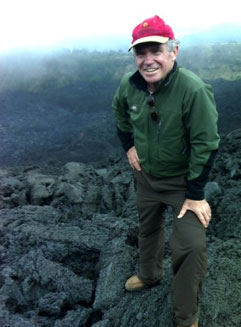From the Back Cover: ‘Deep in the Guatemalan jungle lies the Maya Codex, an ancient document containing a terrible warning for civilisation. Archaeologist Dr Aleta Weizman is desperately searching for the codex, but powerful forces in Washington and Rome will do anything to stop her. When CIA agent Curtis O’Connor joins Aleta in her dangerous quest, he also becomes a target … from the corridors of power in Nazi Germany to modern-day Washington, from the secret archives of the Vatican to the Temple of the Lost
World pyramid in Central America, The Maya Codex takes us on a heart-stopping journey.’
The research (more on the tab below) took me to Vienna – one of my favourite cities and the setting for more than one of my novels – and on to the jungles of Guatemala. While I was taking a break in Antigua, the lovely old capital of present day Guatemala, my guide, Roberto Rodas, and I climbed a nearby active volcano. We were standing at the top when the ground started to rumble beneath us, causing us to make a very quick break for safety. In his words, ‘when an active volcano starts to whisper in your ear, it is better to retreat.’
The search for the Maya Codex, which also contains a chilling warning, takes the reader deep inside the Nazi Party, Reichsführer Himmler’s Schutzstaffel-SS (Hitler’s Praetorian Guard) and the eerie Wewelsburg castle. In 1934, Himmler took over the triangular-shaped castle which towers over the village of Wewelsburg near the Westphalian forests in the Alme valley in Western Germany (today it is a museum to its grisly past).
The Research and Background to The Maya Codex
The prologue to the novel finds Aleta Weizman, the stunningly attractive Guatemalan archaeologist, staring ‘at the falling snow from the window of her apartment in Vienna, contemplating the future with a deep sense of foreboding.’ Across the Judengasse, the cobblestoned street below, stands the 8th Century St Ruprechts. And in the shadows of Vienna’s oldest church, CIA agent O’Connor is observing his quarry.
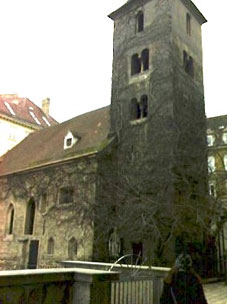
In the shadows of St Ruprechts
Vienna is one of my favourite cities and one that I have visited several times, researching the novels that are set there. It remains a chilling experience to walk down the cobblestones of Judengasse where elegant Jewish shops were trashed and Jews attacked and murdered at the hands of the Nazis. Kristallnacht, the nights (9/10 November 1938) of ‘broken glass’ where Jewish businesses and synagogues were trashed and burned while the fire services looked on, were particularly vicious in Vienna. Today, O’Connor has been ordered to Vienna to assassinate Aleta. Very much her own woman, Aleta is in Vienna for an international conference on the Maya. Back home, she has been openly critical of the atrocities committed Guatemala by dictators like General Montt, who, amongst other CIA-supported leaders, was responsible for the massacre of 200,000 innocent civilians. President Clinton later apologised for the role of the CIA in the massacres, but Aleta’s outspoken criticism has brought her to the attention of the corrupt Director of the CIA, Howard Wiley, who has very good reasons to silence her.
O’Connor returns to his suite in Vienna’s Imperial Hotel, only to have his fears heightened as to the true nature of his assassination mission. As an aside, we should not be surprised that O’Connor, a master at confusing the accounts department back at CIA’s Langley headquarters, should be staying at the Imperial. I stayed in this truly elegant hotel for one night (impecunious authors like me spend their time in less luxurious surrounds).

The Elisabeth Suite at the elegant Hotel Imperial Vienna
Pic: Hotel Imperial
There I fell into conversation with a very knowledgeable barman whose father had worked at the hotel at the time of the Hitler’s Anschluss – the annexation of Austria. Hitler used to stay at the hotel when he visited the Austrian capital and Hitler’s Foreign Minister, SS-Obergruppenführer Joachim von Ribbentrop, set up an Annex there for the Third Reich. This graceful hotel has a fascinating history.
When I started to research this novel, I became aware of Reichsführer Himmler’s interest in any connection between the Master Aryan race and ancient civilizations. In 1933, Himmler met with an old colonel from the Austrian Imperial Army – Karl Maria Wiligut. Impressed with Willigut’s knowledge of the occult and Aryan history, Himmler brought him on to his personal staff, with his old rank of Colonel (Standartenführer) and later promoted him to Brigadeführer (Brigadier-General).
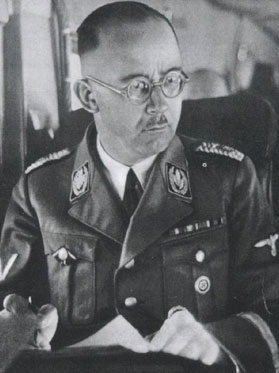
Reichsführer Himmler
Willigut had shown Himmler a yellowed leather-bound manuscript with a fragment of a warning which sounds eerily prescient today:
“When all the trees are destroyed a day will come when the temperatures will soar; when fires will increasingly ravage the land, when earthquakes will bring pestilence and flood and the land will wither; when mankind will become lovers of pleasure; religion will fight religion and the Catholic Church will be destroyed. A prince, with links to the Aryans and an ancient civilisation, will arise from obscurity. He will wear an iron cross on his chest and it is he who will deliver his people.”
As we go back in time to the powerful era of the Third Reich and the search for the Maya Codex, Himmler has personally selected Aleta’s grandfather, Professor Levi Weizman, to lead an expedition to the jungles of Guatemala to recover the ancient document, keeping from Hitler the fact that Weizman is a Jew. The Mayan hieroglyphics were, Himmler knew, notoriously difficult to decipher and Weizman was one of the few archaeologists in the world who might be able to achieve it. For Aleta’s grandfather, his association with Reichsführer Himmler has catastrophic consequences when he, along with Aleta’s grandmother and father, are later interred in the notorious Maut hausen concentration camp in Austria. Not as well known as Auschwitz and others, Mauthausen was arguably even more grisly, with its infamous ‘stairs of death.’ Prisoners were forced to ascend the steep rock stairs with impossibly large boulders on their shoulders, and if they faltered, they were beaten by the ‘less-than-human’ guards. Once at the top, the guards often pushed them off the rock ledge on to the boulders in the quarry below.
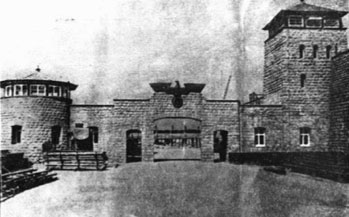
The infamous Mauthausen Concentration Camp in Austria
As part of my research, I travelled to the Mauthausen concentration camp. It was early on a Sunday morning, and I was the first to arrive. I can count on one hand, the occasions I have been moved to tears (the infrequency of which is not necessarily an admirable trait), but as I climbed the stairs of death, this was one of them – and I have brought this camp back to life in the novel.
Once I left Austria to follow the trail of the Maya Codex, I flew to Cancun in Mexico and then travelled by road, south across the border (an interesting exercise in itself where one had to bribe the border guards) and into the jungles of Guatemala in order to take the reader deep into the ancient sites of one of the most extraordinary civilisations to ever populate this planet. Rising in 2000 BC, the Mayans spread across the Yucatán Peninsula in the lowlands of the north, south to highlands of the Sierra Madre – an area encompassing what is today’s Guatemala, Belize (formerly British Honduras), as well as parts of Mexico, El Salvador and Honduras. Their cities, like Chichen Itza, Palenque, Tikal and Copán, with their stunning Mayan pyramids, palaces and ball courts are legendary. At some time in the 9th century though, the Maya abandoned everything they had built, leaving their cities to the ravages of the jungle where they remain today and archaeologists are still arguing as to the reasons – intercity fighting; or perhaps it was the long drought, exacerbated by deforestation as the Maya cleared thousands of square kilometres; but the ruins, as CIA agent Curtis O’Connor and Aleta Weizman were to find out, still hold their secrets.

Himmler climbs the notorious ‘stairs of death’ during a visit to Mauthausen in 1941 - Pic: Bundesarchiv
Much was made of doomsday predictions for 2012 when, for the first time in 25,772 years, the earth aligned with a black hole at the centre of the Milky Way galaxy, just as the Mayans predicted in their long count calendar, all those centuries ago . But many of the Mayan elders I spoke with in Guatemala maintain that the rare planetary alignment on the 2012 winter solstice had a much deeper meaning – an awakening of consciousness, as well as a warning of what is to come if we don’t change course. As the world appears to go to hell in a hand basket in the Middle East and the refugees stream toward Europe, and world leaders are finally accepting what the scientists have been saying for decades – that the world is heating and much of that is due to human activity – what is contained in the Maya Codex may indeed be prescient.
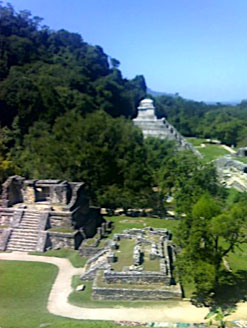
Palenque

In the jungles of Guatemala
